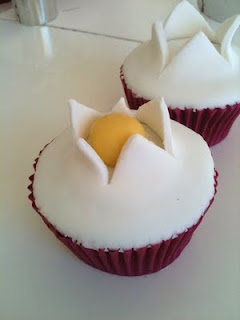Sally does an awesome job of keeping Tasmania supplied with the most intricate, imaginative and brilliant cupcakes. She is also a great teacher and runs regular courses on how to decorate fondant cakes and cupcakes. Pictured on the left are the three patterns we learnt to make in the Easter cupcake course.
Sally demonstrated each technique first....
... Then we sat down at our places and had a look through everything that was laid out for us: full instructions, ready-coloured fondant, three cupcakes which were already ganached, and equipment including a rolling pin, knife and spatula.
First up we made an Easter basket. The cupcake is covered in a pastel shade - I chose blue, but green and pink were also popular choices.
Then we cut a small circle of brown fondant for the base of the Easter basket, and rolled a very very long roll of brown fondant to make the basket weave. It was nearly as hard as actually weaving a real bloody basket.
'Yeah right' you're thinking, 'how difficult can it be to make a sausage roll shape?' ... okay, YOU try making one that's 30cm long and the same smooth diameter at every point. :-(
After passing the 'sausage challenge', we used the roll to make the sides and handle of the basket.
When the handle was stuck in place it started to look okay!
Next, using a dab of royal icing, we stuck a few little eggs in the basket. These were pre-made for us from fondant but you could also use small candy eggs.
Using a little roll of bright green fondant snipped with scissors, we made tufts of grass to nestle against the basket.
To finish off, Sally provided some pre-made flowers. These needed to be pre-made because they take a while to dry - however, when Sally demonstrated the technique she used to make them, they were so logical and so quick that I am keen to make a stack myself and store them.
This is my finished Easter basket yay!
Everyone had different results - all looked great. It's interesting to see the extent to which one pattern can be interpreted in so many different ways and come out looking quite different.
This is another student's basket.
Next we started on the Easter Bunny cupcake. His ears needed to be made first because they required drying time. We rolled and hand cut two oblongs of white fondant and two smaller pink fondant oblongs. These were ten stuck together and pierced with florist's wire to about two thirds of the way up, and one ear was bent over in a flopsy bunny kind of way.
There were plenty of boob jokes flying around at the next stage. We rolled two small balls of fondant and stuck them directly on the top of the cupcake, then rolled and cut out a large circle and stuck it on the top. Although it definitely looks booby at this stage, this is actually the bunny's chubby cheeks. You'll see.
We smoothed the fondant down very carefully - this was the first time I had covered unusual shapes and I was really pleased with how elastic the fondant covering was, so it was quite easy to get a really smooth finish.
Then we cut two small white circles and two smaller black circles for the eyes, taking a little half moon off each so that they could sit right into the 'chubby cheeks'.
We hand-cut the teeth - sort of a V shape so they could sit right up into the cheeks as well.
We dusted the cheeks with a little rose petal dust (see my previous posts for this magical stuff that puts a beautiful blush in fondant cheeks), and used some cake flower stamens as whiskers.
Then all that was left was to stick the ears on, using the end of the florist's wire, and hoppy hoppy, there's the bunny!!
*Trap for young players: I always feel a bit nervous using non-edible equipment in cakes. These have wire in the ears and whiskers - take care if gifting to children!
It would be fair to say that everybody was pretty happy with their bunnies.

The third pattern we did was hatching chickens in eggs, but I am going to write about that separately.
By the time it got to the end of the class, there were intricately-decorated cupcakes just about everywhere.
It was fantastic to be part of a group who were all totally focused on cupcaking. I will say that every member of this group was female. What, boys don't like cupcakes or something??
At the end of the class we proudly gazed at our decorated cupcakes and took them home to be guzzled by (hopefully grateful) spouses, children, flatmates etc.
Thanks Sally for a fantastic Easter experience!
































